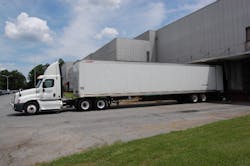Commercial truck carriers and drivers have been bound by the constraints of the hours of service (HOS) rules for quite some time now. It’s not exactly breaking news that these rules have been a challenge for all key players in the industry.
But now, in the era of full enforcement of the electronic logging device (ELD) mandate, where do shippers fit into all of this? And how important is it that they be held accountable for long wait and loading times going forward?
“Whenever I talk to somebody, especially shippers, some don’t understand what’s going on and why all of a sudden this is impacting everything and what we’ve been doing for them,” explained Gary Cardenas, CEO and president of TOC Logistics.
Cardenas, who has worked in international freight forwarding and with North American 3PLs for the last 30 years, started TOC Logistics back in 2009 as a logistics management organization.
“There’s a lack of capacity when it comes to drivers,” Cardenas said, noting that the driver shortage is only expected to worsen under these regulations. “You’ve got a lot of baby boomers that have been truck drivers that are retiring or it’s gotten too difficult to go ahead and make a buck or to run the miles needed to live their lifestyle.”
So, if shippers want to remain competitive in this era of electronic logs, there are some challenges they'll need to overcome, particularly for carriers and drivers.
Shippers are now obligated to watch the clock because they are cutting into the drivers’ driving time. And one delay will end up having a ripple effect on everything.
“These shippers really need to stay a little bit more focused when they’re ordering a truck to come in,” Cardenas said. “They have to make sure they’re not taking an hour or two hours to get trucks in and get them out loaded, especially if they’re looking for a specific transit time to be made.”
On top of that, shippers should keep an eye on when they are ordering and releasing cargo because previous pickups will impact the next pickup for drivers. Shippers should also be concerned about the capacity crunch and trucks “falling off the road” to take higher paying loads, Cardenas explained.
“You want to be with a provider that has built long, vested relationships with multiple carriers, so when push comes to shove, they’re working on your behalf because of the relationship that you’ve built throughout the years,” he added. “Some of these drivers will refuse to pick up a load when they know they’ve had challenges with certain shippers.”
And then there’s the detention problem, which has been a major headache and concern for drivers under strict enforcement of the ELD mandate. Many carriers are now beginning to charge shippers directly for detention time and delays of more than an hour or two.
Because of this, Cardenas noted, some shippers are dropping their wait and load times, though no particular standards have been etched in stone at this point.
“Carriers are [charging detention] to compensate the drivers because drivers are taking a hit now because they are not able to drive as many hours as they were before the ELD mandate,” Cardenas pointed out.
When will all the ELD hype settle down?
“I don’t see it ending anytime soon,” Cardenas said. “I could see this going into next year 2019. I think the capacity crunch is going to be there for a while. Because of the lack of drivers and you have companies scrambling to get driverless trucks.”
“The lack of drivers is key,” he added. “We’re going out there a trying to recruit drivers ourselves with our sister fleet company, and it’s a challenge because everybody is paying them [sign-on] bonuses and giving them a higher rate-per-mile.”
When it comes to enforcement, Cardenas expects patrolling will be highest along major roads and state arteries where the largest amount of heavy-truck traffic moves through.
“This is not going to be over anytime soon, nor are we going to know when this is going to smooth out and going to start determining what the new normal is going to wind up being,” Cardenas stressed.
About the Author

Cristina Commendatore
Cristina Commendatore is a past FleetOwner editor-in-chief. She wrote for the publication from 2015 to 2023.
